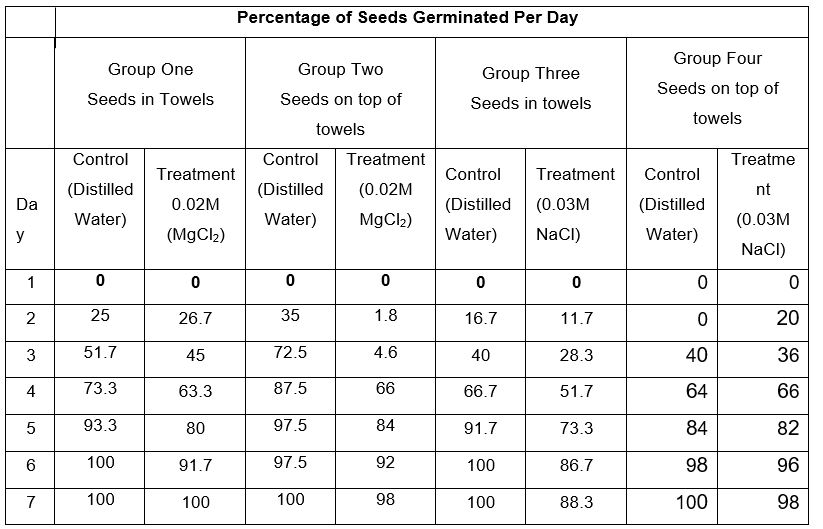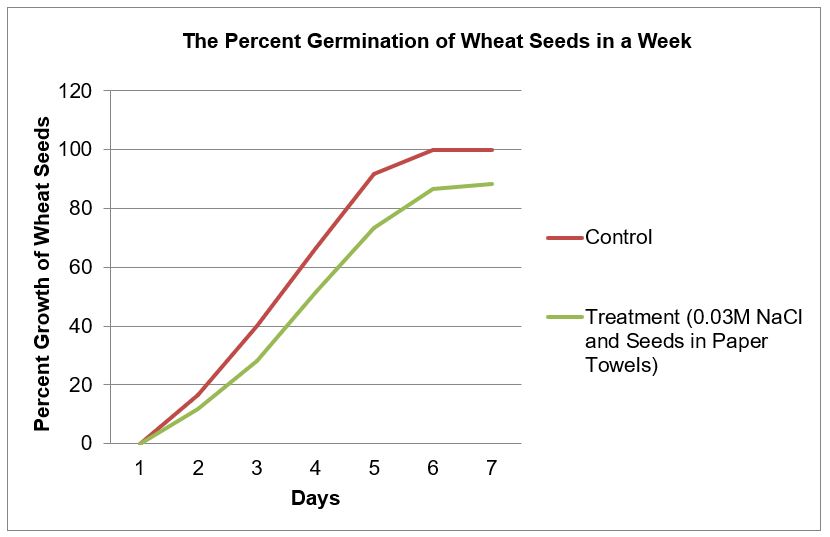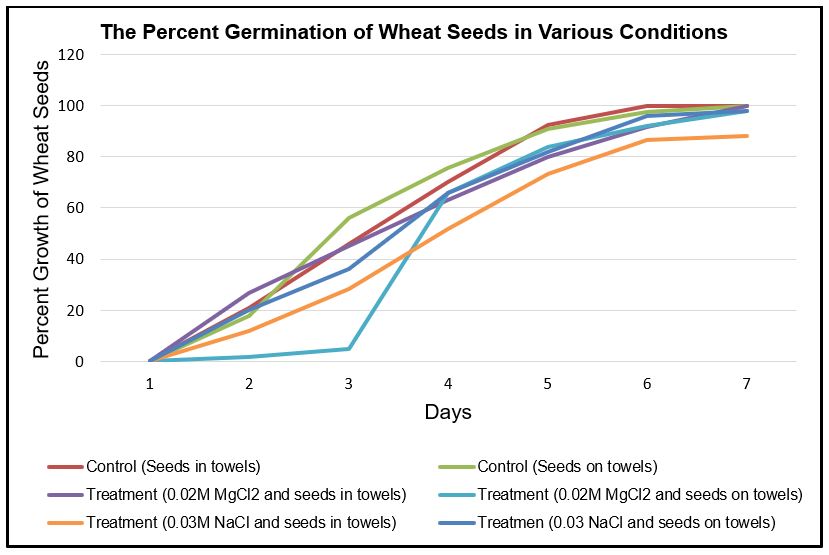Abstract
The concentration of salts in water affects the germination rates of seeds. In this case, the study hypothesized that MgCl2 and NaCl solutions decrease the germination rate of wheat seeds. The purpose of the experiment was to establish how salts influence the germination rate of wheat seeds. To establish how salts, influence the germination rate of wheat seeds, the experiment grown wheat seeds in and on towels wetted with distilled water, MgCl2 solution, and NaCl solution. The findings indicated that wheat seeds grown in salt solutions of MgCl2 and NaCl germinated at a lower rate than the wheat seeds grown in distilled water. Furthermore, the findings show that wheat seeds grown in towels wetted with NaCl solution germinated at a lower rate than wheat seeds that grown on towels wetted with the same solution. Comparative analysis of the findings also indicates that MgCl2 has not major effects on the germination rates of wheat seeds because the percent germination reached 100%. Therefore, the findings support the hypothesis that MgCl2 and NaCl solutions decrease the germination rate of wheat seeds.
Introduction
Seed germination is a natural process that causes seeds to sprout into seedlings, and thus, plants uses in procreation. Water is a requirement of germination that dissolves stored food for the embryo and activates enzymatic processes that trigger germination of seeds (Fuller et al. 1). The physiological process such as osmosis determines the availability of water for the growth of wheat seeds. In this case, the experiment aimed to examine how the amount water influences the rate of germination. Taylor et al. state that cover material of germinating seeds determine the amount of water that seeds imbibe, and thus, influence the rate of germination (83). Hence, the experiment placed seeds inside the wet towels or on top of the wet towels to compare their growth rate.
Moreover, the experiment aimed to examine how salts influence the rate of germination. As seeds usually absorb water from the environment through the process of osmosis, salts reduce their osmotic potential. Fuller et al. state that salinity inhibits germination of seeds by reducing the osmotic potential of seeds and creating physiological drought (1). In essence, the occurrence of osmosis is subject to the extent of salinity of the water that surrounds the seeds. According to Bojovic et al., the concentration of inorganic ions such as K+, Na+, and Cl–, influences the rate of seed germination for they reduce the osmotic potential of seeds (83). In this experiment, Na+, Mg2+, and Cl– are inorganic ions that inhibit germination of wheat seeds because they reduce their osmotic potential and create physiological drought. Therefore, in line with the aims, the study hypothesized that MgCl2 and NaCl solutions decrease the germination rate of wheat seeds.
Method and Materials
The materials that the experiment used to demonstrate the rate of germination of seeds for 7 days are wheat seeds, distilled water, 0.03M NaCL, 0.02M MgCl2, paper towels, and Ziploc bags. The experiment was performed by 22 participants, who were clustered into four groups. The first and the second groups comprising 6 and 5 participants respectively who used 0.02M MgCl2 in wetting paper towels while the third and the fourth groups comprise 6 and 5 participants respectively who used 0.03M NaCl in wetting paper towels. Moreover, in the first and the third groups, the wheat seeds were placed in wetted paper towels whereas in the second and the fourth groups, the wheat seeds were placed on top of the wetted paper towels.
In the first group, 10 wheat seeds were put in the folded paper towel by each of the participants. The folded paper towels with wheat seeds in them were wetted using 5ml of 0.02M MgCl2 and then they were each placed in Ziploc bag. In the second group, 10 wheat seeds were put on top of the folded paper towel by each of the participants. The folded paper towels with wheat seeds on top of them were wetted with 5 ml of 0.02M MgCl2 and were then placed properly in Ziploc bag. In the third group, 10 wheat seeds were put in the folded paper towel by each of the participants. The folded paper towels with wheat seeds in them were then wetted with 5ml of 0.03M NaCl and sealed in Ziploc bag. In the fourth group, 10 wheat seeds were put on top of the folded paper towel by each of the participants. The folded paper towels with wheat seeds on top of them were wetted with 5ml of 0.03M NaCl and then placed in Ziploc bags. The control experiment was done by each participant by putting 10 wheat seeds in paper towels that were wetted with 5ml of distilled water and then placed them in Ziploc bags.
The sealed Ziploc bags containing wheat seeds were placed in a place with same natural conditions of light (windowsill) and temperature (62 Fahrenheit) to allow germination to occur. The number of seeds that germinated in each Ziploc bags was counted daily for one week. The average of the seeds that germinated was determined in each group, and the percent germination was calculated and comparatively presented using a table and graphs.
Results
The results of the experiments were presented in a table (Table 1) and figures (Figure 1 and Figure 2).

Table 1 provides a summary of the findings for it shows the percentages of wheat seeds in each group that germinated each day for one week. The table also shows that the percent growth of wheat seeds in control sets is higher than the ones in experimental sets. Moreover, the experiment indicates that the percent germination of wheat seeds in all control sets reached 100% while the wheat seeds in one experimental set did reach 100%. Overall, the table shows that wheat seeds in different conditions have different percent germination.
The graph below (Figure 1) illustrates the percent germination of wheat seed in paper towels wetted with 5ml of 0.03M NaCl solution and wheat seeds in paper towels wetted with distilled water. It is apparent that the rate of germination of wheat seeds treated with 0.03M NaCl is lower than wheat seeds treated with distilled water.

The graph below (Figure 2) illustrates the comparison of the percent germination of wheat seeds in various conditions. In the control experiments, wheat seeds placed in and on towels exhibited the highest germination rates. Wheat seeds treated with 0.02M MgCl2 and placed in and on towels exhibited different percent germination rates, which is lower than that of control experiments. The wheat seeds in towels showed steady growth rate that culminated in 100% germination while the wheat seeds on towels showed slow germination rate during the first three days and increased exponentially to 98% germination during the seventh-day. The percent germination of wheat seeds placed in towels wetted with 0.03M NaCl is lower than the percent germination of wheat seeds placed on towels wetted with the same solution. The germination rate of the wheat seeds placed on towels reached 98% while the percent germination rate the wheat seeds placed in towels reached 88.3%.

Discussion
The summary of the findings as shown in Table 1 indicate that the percent germination increases with time. Although the germination of wheat seeds increases with time, the rate of germination varies according to the prevailing conditions. The conditions, in this case, are the presence of salts and the extent of covering of the germinating wheat seeds. Zhang, Rue, and Wang state that salt ions cause osmotic stress, which inhibit seeds from absorbing water via osmosis (527). In this case, salt ions of NaCl and MgCl2 inhibit the germination of wheat seeds. Moreover, the amount of water available for the germination process to occur influences the germination rate of seeds. Taylor et al. assert that the extent of covering seeds influence the amount of moisture confined to germinating seeds (84). In essence, the placement of seeds inside or on top of the towels influenced the availability of water or the osmotic stress.
Figure 1 shows that wheat seeds placed in towels wetted with 0.03NaCl solution germinate slower than the wheat seeds placed in towels wetted with distilled water. The explanation for the germination is that wheat seeds placed in towels wetted with 0.03NaCl solution experience the osmotic stress and physiological drought, which slow down the rate of germination. In contrast, wheat seeds placed in towels wetted with distilled water do not experience the osmotic stress, and thus, they imbibe water through osmosis quite easily. Taylor et al. hold that the nature of covering influences the level of moisture that seeds require to germinate (83). The covered wheat seeds have sufficient moisture to sustain the growth of the germinating seeds while uncovered wheat seeds do not have sufficient moisture. In contrast, seeds covered with towels wetted with the solution containing a high concentration of salts experience the osmotic stress, and thus, they do not germinate faster than uncovered seeds.
Figure 2 is a graph that compares the percent germination of wheat seeds in various conditions. The wheat seeds in control experiments, which are placed in and on towels wetted with distilled water exhibited the highest percent germination rate when compared to those placed in and on towels wetted with 0.02M MgCl2 and 0.03M NaCl solutions. The explanation is that the wheat seeds grown in and on towels wetted with 0.02M MgCl2 and 0.03M NaCl solutions experienced the osmotic stress, which prevented them from absorbing sufficient water for their growth. Mirzaei et al. established that salinity inhibits the growth of wheat seeds because salts induce the osmotic stress and create physiological drought (1090). Therefore, the slow germination rate of wheat seeds is due to the osmotic induced by Mg2+, Na+, and Cl– ions.
Moreover, comparison of the placement of wheat seeds gives some invaluable findings. In the wheat seeds treated with 0.02M MgCl2 solution, it is evident that the seeds placed in towels exhibited steady germination rate that reached 100% whereas the seeds placed on towels exhibited slow growth at first then exponential germination rate that reached 98%. Taylor et al. indicated that the extent of cover determines the amount of moisture that seeds absorb (84). In this view, the seeds placed in towels obtained enough moisture while the seeds on towels did not absorb enough moisture. In the comparison of wheat seeds treated with 0.03M NaCl, it is apparent that the seeds paced in towels exhibited slower germination rate that reached 88.3% than the seeds placed on towels. The possible explanation for the occurrence is that seeds placed in towels experienced a higher osmotic stress than the seeds placed on top of the towels. Overall, the findings support the hypothesis that MgCl2 and NaCl solutions decrease the germination rate of wheat seeds.
Conclusion
Germination is a natural process that is subject to several factors. Water is one of the major factors that influence the rate of germination of seeds. As the study aimed to establish how salts influence the germination rate, the findings revealed that MgCl2 and NaCl solutions decrease the germination rate of wheat seeds. These salts reduce the osmotic potential of seeds and increase the osmotic stress leading to physiological drought. Therefore, the findings support the hypothesis that MgCl2 and NaCl solutions decrease the germination rate of wheat seeds.
References
Bojovic, Biljana, Gorica Delic, Marina Topuzovic, and Milan Stankovic. “Effects of NaCl on seed germination in some species from families Brassicacea and Solanaceae.” Kragujavac Journal Science 32.1 (2010): 83-87. Web.
Fuller, Michael, Jalal Hamza, Hail Rihan, and Mohammad Al-Issawi. “Germination of primed seed under NaCl stress in wheat.”ISRN Botany 1.167804 (2012): 1-5. Web.
Taylor, Kurt, Muchha Reddy, Carl Niedziela, Mary Peet, and Godfrey Gayle. “Effect of root substrates and seed cover materials on the germination and growth of organic tomato transplants.”Journal of Applied Horticulture 14.2 (2012): 83-87. Web.
Mirzaei, Amir, Rahim Naseri, Tahereh Emami, and Askar Jozeyan. “Effect of salinity on germination and seedling growth of bread wheat (Triticum aestivum L.).” International Journal of Agriculture and Crop Sciences 4.15 (2012): 1089-1091. Web.
Zhang, Qi, Kevin Rue, and Sheng Wang. “Salinity effect on seed germination and growth of two warm-season native grass species.” Horticulture Science 47.4 (2012): 527-530. Web.